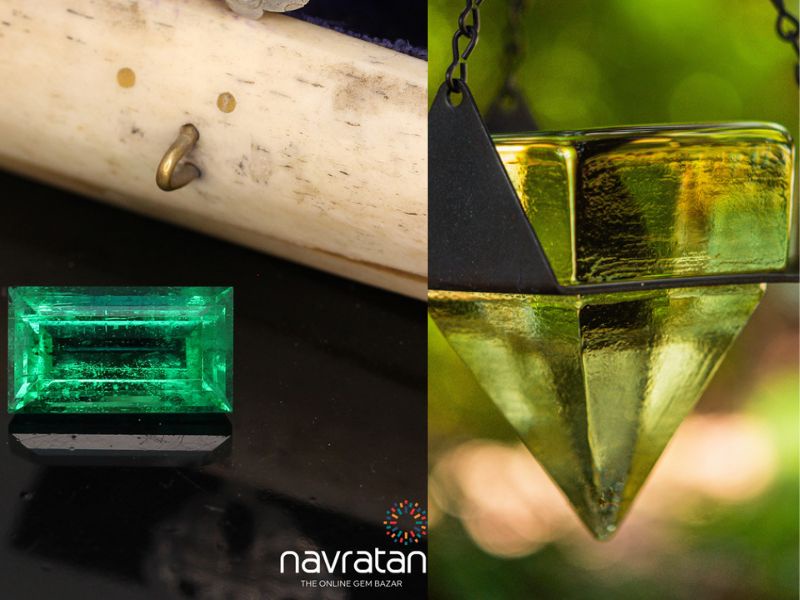Numerous green gemstones exist, with Emerald and Peridot being the most common. Although both gems share a similar green color, they have distinguishable variations in shades. Emerald stones typically exhibit a richer and more vibrant hue of green, whereas Peridots display a slightly lighter and olive-toned green shade. In this article, we aim to delve into the characteristics of Emeralds and Peridots to assist you in selecting the one that best suits your preferences.
Difference in Formation
Emeralds are created in hydrothermal veins found in the Earth's crust. These veins serve as channels for hydrothermal fluids, which are heated water solutions consisting of various elements, gasses, and compounds that occur naturally due to geological events. The mineral beryl, composed of beryllium, aluminum, silicon, and oxygen, is the source of Emeralds. When chromium is added to beryl, it produces the signature green color of Emeralds.
On the other hand, Peridot is one of only two gemstones that form in the Earth's mantle, a layer deeper than all other gemstones. Along with Diamonds, Peridots are brought to the surface of the Earth by geological events such as volcanic activity and the movement of tectonic plates. Olivine is the mineral group that Peridot belongs to and is composed of fayalite and forsterite. The depth of green in Peridot depends on the amount of iron in the stone.
The difference in Value and Rarity
Finding large and high-quality Emeralds is a rare occurrence. Due to their scarcity, exquisite beauty, and historical significance, Emeralds are exceptionally valuable gemstones. Their price ranges from ₹ 2,000 to ₹ 20,000 per carat, depending on their quality, which is evaluated using the 4C's, just like Diamonds. The 4 quality parameters utilized to evaluate the worth are cut, color, clarity and carat weight.
On the other hand, Peridot is a semi-precious stone that is more readily available than Emeralds, though still quite scarce. It is graded using the same 4Cs as Emeralds and Diamonds. Despite its rarity, Peridot stone generally costs less, ranging from ₹ 400 to ₹ 2,000 per carat. The presence of internal inclusions can significantly reduce its value.
However, these price ranges get further exceeded in the case of both these stones when the rarity and quality is exceptional.
Difference in Cultural significance
Emeralds have been highly valued and traded as early as 4000 BC. It is the designated birthstone for May and is also associated with the zodiac sign Cancer, which is often linked to Ireland, although Emeralds are not found there naturally. It is also believed to have the ability to open the heart.
Peridot has been mined since 1500 BC, as evidenced by early records. It was often mistaken for more valuable gemstones. Legend has it that Cleopatra favored Peridot as her gemstone, although she believed it to be Emerald. Peridot is one of the several birthstones for August.
Difference in Birthstones
The Emerald gemstone also referred to as Panna Ratna in Hindi is traditionally known as the birthstone for people born in the month of May. In contrast, the Peridot stone also referred to as the Money stone or Ghritmani in Hindi is the designated birthstone for the people born in the month of August.
The difference in Type of Gemstone
Emeralds are considered precious gemstones due to their rich physical and metaphysical properties and historical significance. On the other hand, Peridot is classified as a semi-precious stone. Because it resembles Emerald, Peridot can be a good alternative for those who cannot afford the high cost of Emeralds.
Difference in Origin
The best quality Emeralds are mined in Zambia, Brazil, and Colombia, while Peridots are sourced from the USA, Egypt, and Myanmar.
The difference in Astrological properties
The Emerald gemstone is associated with Mercury and is believed to bring wealth, good fortune, and happiness. On the other hand, Peridot is ruled by both Mercury and Venus.
Difference in Color
The finest quality Emeralds have a deep, rich green color with a bluish undertone caused by trace amounts of chromium and vanadium. The amount of iron in the stone also affects the depth of its color, with darker shades indicating higher iron content.
Peridot is exclusively available in shades of green, ranging from lustrous, light olive green to a bright, intense green hue. Its color intensity varies based on the amount of iron within its chemical composition, and its undertones can range from yellowish-green to light brown. Peridot is a dichromatic gemstone whose color comes solely from the minerals in its primary composition, which include magnesium and iron.
In contrast, Emeralds derive color from trace amounts of other metals in their chemical makeup. The beryl is colorless without these impurities, and Emeralds are therefore known as allochromatic gemstones.
The difference in Pattern and Clarity
Genuine Emeralds have natural flaws that are easily visible due to their glass-like appearance. They typically have a prismatic crystal shape with a hexagonal crystal system and imperfect cleavage in one direction. While some Emeralds may undergo treatments to improve their clarity and appearance, they are still considered imperfect.
In contrast, Peridot usually has no visible inclusions and a transparent appearance, although impurities can cause slight cloudiness. The stone is rarely treated, but it can be filled with epoxy to enhance clarity. Polished Peridot has a vitreous luster, excellent transparency, and a conchoidal fracture with a distinct cleavage.
Difference in Hardness
Emeralds are slightly more durable than Peridots, with a hardness rating of 7.5-8, while Peridots score between 6.5-7. However, both stones require proper care and maintenance to ensure longevity. While Emeralds can withstand daily wear, Peridot jewelry may be better suited for special occasions. Emeralds are incredibly robust, whereas Peridots are relatively fragile in comparison.
Verdict
Emeralds with tiny flaws are often preferred over flawless ones, which are considered more authentic. However, if you desire a naturally flawless Emerald, be prepared to pay a steep price.
On the other hand, Peridots are rarely treated, as most of them do not have visible inclusions. You can expect exceptional clarity and vibrant color from a high-quality Peridot gemstone. Moreover, compared to Emeralds, Peridots are considerably less expensive, even if you opt for a three or four-carat stone. Peridot is an excellent choice if you have a limited budget but want to add a pop of fresh and vivid color to your collection.
However, if you are looking for a precious gemstone that can be passed down through generations, an Emerald is undoubtedly the better choice.
Where to Buy
You can conveniently purchase natural Emerald and Peridot gemstones while sitting at your homes through our online store at Navratan.com.


No comments yet